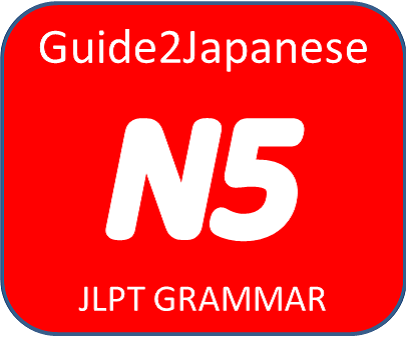JLPT N5 GRAMMAR: に Particle
Meaning: to, from, at, for (~को, ~से, ~मे, ~के लिए, ~हेतु से)
When a verb denotes a momentary action or movement , the time when it occurs is marked with に. に is added when the noun before it uses a numerical as N(time)に Verb
- Example:
- 私は毎朝6時に起きます。
- Watashi wa maiasa 6-ji ni okimasu.
- I get up at 6 o’clock every morning.
- मैं रोज सुबह 6 बजे को उठता हूं।
- テレサちゃんは毎晩11時に寝ます。
- Teresa-chan wa maiban 11-ji ni nemasu.
- Theresa sleeps every night at 11:00.
- टेरेसा हर रात 11 बजे को सोती हैं।
- あなたは何時に起きますか。
- Anata wa nanji ni okimasu ka.
- At what time do you wake up.
- आप किस समय (को)उठते हैं।
Verbs like あげます、貸します、教えますetc., need persons to whom you give, lend, teach etc. The persons are marked with に。 For other verbs, に can be attached to name of place or thing, in those case we can also use へ instead of に.
- 山田さんは木村さんに花をあげました。
- Yamada-san wa Kimura-san ni hana o agemashita.
- Yamada gave Kimura a flower.
- श्री यामादा ने श्री किमुरा को फूल दिये।
- イー さんに本を貸しました。
- Ī-san ni hon o kashimashita.
- I lent a book to E.
- मैंने मिस्टर ई को एक पुस्तक दी।
- 太郎君に英語を教えます。
- Tarōkun ni eigo o oshiemasu.
- I will teach English to Taro.
- मै तारो को अंग्रेजी सिखाऊंगा।
- 会社に電話をかけます。
- Kaisha ni denwa o kakemasu.
- I will Call the company.
- कंपनी को फोन करुंगा।
Verbs like もらいます、かります and なります express actions from the receiving side. The person from whom you receive those actions are marked with に。When you receives something from any organization, we have to use から instead of に.
- 木村さんは山田さんに花をもらいました。
- Kimura-san wa Yamada-san ni hana o moraimashita.
- Kimura got flowers from Mr. Yamada.
- किमुरा को यामादा से फूल मिले।
- カリナさんにCDを借りました。
- Karinasan ni CD o karimashita.
- I borrowed a CD from Karina.
- मैंने करीना से एक सीडी उधार ली ।
- ワンさんに中国語を習いました。
- Wan-san ni chūgokugo o naraimashita.
- I learned Chinese from Wan.
- मैंने वान से चीनी सीखी।
- 銀行からお金を借りました。
- Ginkō kara okane o karimashita.
- I borrowed money from the bank.
- मैंने बैंक से लोन लिया।
The purpose for いきます・きます・かえります is expressed using this pattern. The purpose is marked with the particle に. A noun used before に is of the kind denoting an action.
Formation: N(Place)へVますーForm / N )にいきます/来ます/帰ります
- 神戸へインドの料理を食べに行きます。
- Kōbe e Indo no ryōri o tabe ni ikimasu.
- I am going to kobe to eat Indian food.
- मैं भारतीय खाना खाने के लिए कोबे जा रहा हूं।
- 神戸へ買い物に行きます。
- Kōbe e kaimono ni ikimasu.
- I’m going to Kobe for shopping.
- मैं कोबे खरीदारी करने के लिये जाऊंगा।
- 日本へ美術の勉強に来ました。
- Nihon e bijutsu no benkyō ni kimashita.
- I came to Japan in order to study art.
- मैं कला का अध्ययन करने के लिए जापान आया।
- 忘れ物を取りに家へ帰りました。
- Wasuremono o tori ni ie e kaerimashita.
- I returned home to retrieve my lost items.
- मैं अपनी खोई हुई वस्तुओं को पुनः प्राप्त करने के लिए घर गया।
It is also used for denoting nouns to events such as Festivals and concerts before に. In this case the speaker’s purpose is to see or enjoy the event.
- 京都のお祭りに行きます。
- Kyōto no omatsuri ni ikimasu。
- I will go to the festival in Kyoto tomorrow.
- मैं क्योटो में एक उत्सव में जा रहा हूं।
- 花火大会に行きます。
- Hanabi taikai ni ikimasu.
- I will go to see fireworks.
- मैं आतिशबाजी देखने जाऊंगा।
The partical に marks the goal when used with verbs like はいります、のります etc.
- あの喫茶店に入りましょう。
- Ano kissaten ni hairimashou.
- Let’s go in that copy shop.
- उस कॉफी शॉप में जाते हैं।
It also used with the meaning “as a token of” or “in memory of.”
- 田中さんが 結婚のお祝いにこのお皿をくださいました。
- Tanaka-san ga kekkon no oiwai ni kono o sara o kudasaimashita.
- Mr. Tanaka gave me these plates as my wedding gift.
- श्री तानाका ने विवाह के तोहफे के तौर पे यह थाली दी।
- 私は北海道旅行のお土産に人形を買いました。
- Watashi wa hokkaidōryokō no omiyageni ningyō o kaimashita.
- I bought a doll as a Sovenier of the trip to Hokkaido.
- मैंने अपनी होक्काइडो यात्रा के स्मारिका के रूप में एक गुड़िया खरीदी।



